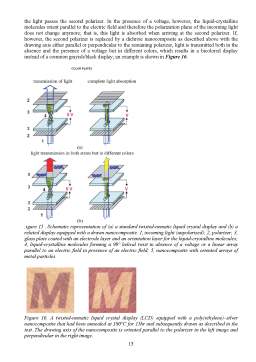Cuprins
- 1 Introduction in the properties of nano-sized particles 3
- 1.1 Specific properties of nanoclusters 3
- 1.2 Nano-sized metals embedded in polymers 3
- 2 Synthesis of organic-inorganic compounds 4
- 2.1 Metal- polymer syntesis 4
- 2.2 Formation of Colloid Nanoparticles 4
- 2.3 Self-Assembly of Colloid Nanoparticles 4
- 2.4 Sol-Gel Deposition 5
- 2.5 Electrostatic Self-Assembly 6
- 3 Optical properties of nano-sized particles 7
- 3.1 The Effect of Quantum Confinement on Optical Properties of Low-Dimensional Systems 7
- 3.1.1 Electron in a Quantum Box 7
- 3.1.2 Luminescence 9
- 3.2 Optical Constants of Organic/Inorganic Nanostructures 10
- 3.2.1 Method of Ellipsometry 10
- 3.2.2 Optical Constants of Thin Organic Films 11
- 3.3 Optically Anisotropic Metal–Polymer Nanocomposites 12
- 3.3.1 Applications of dichroic nanocomposites 12
- 4 Experimental studies of the optical properties of organic-inorganic nanocomposites 14
- 4.1 Influence of nanocrystals on the energy levels and luminescent properties of the polymer matrix in conjugated polymer–dielectric nanocomposites 14
- 5 Applications 16
- 6 Bibliography 17
Extras din proiect
1.1 Specific properties of nanoclusters
As advanced technologies are expanding, the need for novel functional materials significantly increases. Nowadays, materials with a special combination of properties (e.g., magnetic–transparent, conductive–transparent, catalyticmagnetic, etc.) are strictly required.
A nanocluster is a tiny chunk of the bulk measuring a few nanometers with a finite number of atoms in it.. The nano-sized clusters display a remarkable tendency to remain single-crystalline and hence are also called nanocrystals. In addition, nanocrystals possess a high surface area: a great fraction of atoms in a nanocrystal is on its surface.
An added dimension to research on nanocrystals is their size-dependent properties. The electronic, magnetic, and optical properties of a nanocrystal depend on its size. In small nanocrystals, the electronic energy levels are not continuous as in the bulk but are discrete, due to the confinement of the electron wavefunction to the physical dimensions of the particles. This phenomenon is called quantum confinement; therefore, nanocrystals are also known as quantum dots. In other words, a small nanocrystal could be a very bad conductor, although nanocrystals are tiny silhouettes of the conducting bulk. Likewise, a tiny nanocrystal of a ferromagnet can be paramagnetic in nature.
In several respects, small nanocrystals behave like molecules. The nanocrystals can be discretely charged with electrons with characteristic charging energies. This means that a nanocrystal carrying an extra electron can exhibit properties different from those of a neutral species. The nanocrystals akin to covalent systems selfassemble into ordered arrays in one, two, and three dimensions under the right conditions. Lattices of nanocrystals consist of interacting nanocrystals and may exhibit novel properties arising out of such interactions.
However, the difficult handling ofthese incredibly small objects (1–30 nm) has represented a strong limitation to their use. Manipulations of single nanoscopic objects by surface tunneling microscopy (STM), spontaneous self-assembly, and dielectrophoresis are the only available approaches for building functional devices using nano-sized metals.
1.2Nano-sized metals embedded in polymers
Nano-sized metals with sizes in the range of 1–50 nm are considered important and are obtainable as sols—a dispersion of a solid in a liquid. Metal sols possess fascinating colors and have long been used as dyes and catalysts. Modern techniques of synthesis enable one to obtain sols of metals that can be dried and redissolved like water colors
In addition, most of nano-sized metals are very instable: They can aggregate because of the high surface free energy and can be oxidized contaminated by air, moisture, SO2, and so on. The embedding of nanoscopic metals into dielectric matrices represents a valid solution to the manipulation and stabilization problems.
In the functional field, polymers are particularly interesting as an embedding phase, since they may have a variety of characteristics: They can be an electrical and thermal insulator or conductor, may have a hydrophobic or hydrophilic nature, can be mechanically hard, plastic, or rubbery, and so on. Finally, polymer-embedding is the easiest and most convenient way for nanostructured metals’ stabilization, handling, and use.
Polymer-embedded nanostructures are frequently termed nanocomposites because of their biphasic nature. The fundamental knowledge on the preparation and proposed confinement effects arise in nano-sized metal domains since conduction electrons are allowed to move in a very small space, which is comparable to their De Broglie wavelength; consequently their states are quantized just like in the atoms, and these systems are termed artificial atoms.
Surface effects are produced because with a decrease in size, matter consists more and more of surface atoms than of inner atoms. As a result, the matter properties slowly switch from that determined by the characteristics of inner atoms to that belonging to surface atoms. In addition, the surface nature of a nano-sized object significantly differs from that of a massive object. Atoms on the surface of a massive crystalline solid are principally located on basal planes, but they transform almost completely in edge and corner atoms with a decrease in size. Because of the very low coordination number, edge and corner atoms are highly chemically reactive, supercatalytically active, highly polarizable, and so on, in comparison with atoms on basal planes. Because of quantum-size effects, mesoscopic metals show a set of properties completely different from that of their massive counterpart.
Particularly interesting is: the size-dependent ferromagnetism and the superparamagnetism characterizing all metals (included diamagnetic metals like silver); the chromatism observed with silver, gold, and copper metals due to plasmon absorption; the photo- and thermoluminescence; and the supercatalytic effect (hyperfine catalysts are characterized by an extraordinarily higher catalytic activity and a different selectivity compared to corresponding fine powders).
In addition, because of the band-structure disappearance, metals become thermally and electrically insulators at very small sizes. They are highly chemically reactive (heterogeneous reactions become stoichiometric and new reaction schemes are possible, for example: nano-sized noble metals are very reactive), are super absorbent, and show completely different thermodynamic parameters (for example, they melt at much lower temperatures
Preview document
Conținut arhivă zip
- Organic-Inorganic Nanocomposites.doc

















